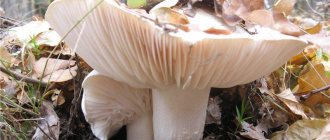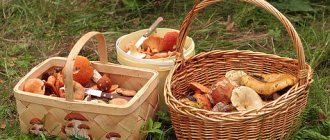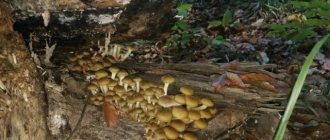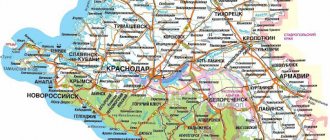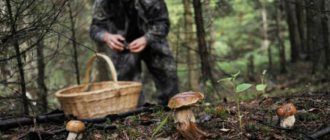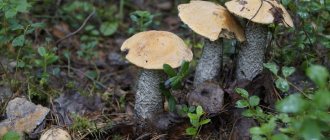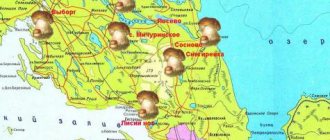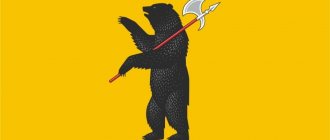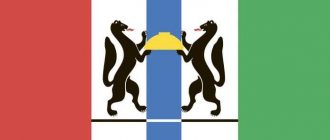It is believed that “silent hunting” is not relevant in winter, because this time is not suitable for collecting mushrooms. But experienced mushroom pickers go to the forest even in the cold season to find a storehouse of useful substances - flammulina - hidden under the thick snow.
Winter honey fungus is especially valued in Japan for its medicinal properties; it has excellent taste and is used to prepare several dozen dishes.
Description of the appearance of the mushroom and its characteristics
Winter honey fungus belongs to the edible mushrooms of the family Oryadovaceae or Negniuchkovye.
In literary sources it is called Flammulina or Collibia velvety-footed, Enokitake or Winter mushroom. Fruits in colonies, found in fused form. The cap is round and convex, but becomes flat with age. The surface is flat, smooth, with a large accumulation of mucus, which does not disappear even after heat treatment. The diameter ranges from 2 to 8-12 cm. The color palette varies from golden-honey to orange-brown, a light shade and transparent stripes are present at the edges, while the leg is painted in a darker color.
The leg is tubular in shape, resembling a cylinder. It has a dense, velvety structure. Height is from 2 to 8 cm, diameter is 0.3-1 cm. The upper part has a yellowish tone, the lower part is more saturated, most often reddish-brown.
The pulp is juicy, colored white or pale yellow, tougher at the lower edge of the stem and tender in the cap area. The smell and taste are pleasant, but mild.
The plates are adherent to the stem, sparse, sometimes shortened. Young fruiting bodies have a cream or light yellow color, but over time it changes to a darker color. White spore powder.
The shape of the spores ranges from cylindrical to ellipsoid.
Winter honey fungus is an edible mushroom that contains many useful substances:
- amino acids;
- protein;
- zinc;
- potassium;
- iodine;
- antioxidants.
It is used in cooking, pharmacology, cosmetology and medicine. Scientists have found that the substance flammulin, which is found in large quantities in winter honey fungus, is effective for the prevention of sarcoma and the treatment of benign tumors - fibroids, fibroids, adenomas, mastopathy, as well as thrombophlebitis.
When consuming winter mushrooms, the development of neoplasms is inhibited, the immune system is strengthened, cholesterol levels are reduced and liver cells are restored. But there are a number of contraindications:
- diseases of the gastrointestinal tract;
- allergy;
- pregnancy and lactation period.
Important! The mushroom should not be eaten by children under 10 years of age. Their bodies do not produce the enzymes necessary for digestion.
Loader white
But this is not a milk mushroom at all, or even a milk mushroom, but a very ordinary russula, very similar to representatives of the noble milk mushroom breed. The main distinguishing feature is the absence of milky juice, for which this mushroom is often called “ dry milk mushroom ”. By the way, thanks to this remarkable circumstance, the flesh of the white mushroom does not have the acridity characteristic of milk mushrooms. Therefore, it can be cooked without prior soaking or boiling.
In terms of taste, it is considered the best of all loadings. Don’t believe Wikipedia, which claims that the mushroom supposedly has a “bland” taste - this is nothing more than the sofa rantings of amateurs who have only seen mushrooms in the supermarket. Dry milk mushrooms are very good, either pickled or fried with potatoes.
This fungus forms mycorrhiza with many trees. Loaders have been seen under birch, oak, beech, aspen, alder, pine and spruce. But, as practice shows, most of them grow in birch forests. Dry mushrooms bear fruit from July to August .
Collection time and place
Flammulina grows almost everywhere, but most often winter mushrooms can be collected in temperate northern latitudes. The fungus leads a parasitic lifestyle, settling in dead, damaged or weakened coniferous and deciduous trees - willows, poplars, maples, aspens, lindens, growing at the edge of the forest, near streams and rivers. Sometimes winter honey fungus is found in park areas or gardens.
The time for collecting winter mushrooms depends on the climatic characteristics of the growing area. The first harvest season occurs at the end of September - beginning of October. Winter honey mushrooms love dampness, and in conditions of high humidity they bear fruit much faster.
But the peak of increased growth occurs in November-February, remaining until May. Flammulina continues to develop even in winter during the thaw, hiding under the snow cover. Therefore, you can collect mushrooms from autumn to spring.
Important! Winter honey fungus, like any other mushroom, has the ability to absorb harmful substances from the environment. Mushrooms should be collected in places with a favorable environmental situation, away from highways and railways.
At what temperature do they grow?
The rapid growth of winter mushrooms begins when the temperature drops to 10 degrees, because these mushrooms prefer chilly weather and high humidity. But one of the most interesting features of flammulina is that it tolerates frost well, being under thick snow cover.
When the temperature drops significantly, the mushroom freezes and its cap begins to crumble when pressed. So he falls into a state of suspended animation, but does not die. And during the first thaw, its development resumes, and the structure of the fruiting body becomes the same.
Important! Experienced mushroom pickers do not miss the opportunity to visit the forest in the cold season and pick frozen mushrooms, which, when thawed, regain their firmness, elasticity and taste.
Are milk mushrooms healthy?
- These mushrooms are nutritious, the flesh is fleshy and contains proteins (33 g per 100 g after drying), carbohydrates, minerals and vitamins in an easily digestible form. Boiled milk mushrooms replace meat and fish if these products are contraindicated.
- Vitamins B, A and C improve the function of the nervous system, hematopoiesis, and immunity.
- Minerals in bioavailable form - sodium, magnesium, calcium and phosphorus, the active form of vitamin D are involved in the prevention of osteoporosis, maintain healthy skin and hair.
- The antibacterial agents of pepper milk kill the tuberculosis bacillus and treat kidney stones in folk medicine.
- Fermentation and fermentation of milk mushrooms activates the production of lactic acid, anti-inflammatory and cholesterol-lowering substances.
Autumn, summer and winter honey mushrooms: time difference
Autumn honey mushrooms, like winter ones, prefer deciduous wood and settle on both dead and living trees. Winter honey mushrooms appear in waves with an interval of 15 to 20 days during the cooling period - at the end of August. And they can grow until the end of October.
Until this month, you can also collect summer honey mushrooms, which can be found in abundance on rotting wood, most often on birch. But unlike autumn and winter ones, they begin to grow from the very beginning of summer.
The season of winter mushrooms occurs at the end of autumn, but during thaws they also develop in winter. Fruiting in flammulina can last from the end of September until May, but much in this case depends on the characteristics of the region of growth and temperature conditions.
When to collect
Expert opinion
Gennady Sergeevich Rylov
A great expert in mycology and an avid mushroom picker. Knows everything about mushrooms, their types and places of growth
Experienced mushroom pickers know that it is best to look for mushrooms in dry, sunny weather. If, after rainy weather, drought sets in and the air temperature remains above twenty degrees, then you can confidently go on a “quiet hunt.”
Milk mushrooms are collected both in the forest and in the country. In order to determine the presence of a mushroom, you need to look at the ground under the tree; if there are traces of forest debris, then a milk mushroom is growing under it. Also, there should be no cobwebs, dry leaves or pine needles on the ground. Look from the tree trunk to the edge of the foliage. The mushroom must be dry and free of damage and stains, otherwise they may be infected with fungus gnat larvae. If mushrooms grow near large trees, then it is necessary to check them so as not to collect them near the patient.
It is better to cut with a large knife, and it is better to choose it from stainless steel. Mushrooms should not be wormy. They may be inedible. After collection, they must be processed immediately. You need to rinse the mushrooms under running water, remove all leaves and other debris.
It is best to soak them in water before processing, or better yet, in salt water for an hour. After this, the mushrooms must be thoroughly washed. They are soaked to remove the bitterness.
Unfortunately, it is not always possible to determine whether a mushroom is edible or not. Even an experienced mushroom picker is shocked when poisonous specimens are found in the basket.
Such species usually grow in large groups and look beautiful, their caps even acquire a beautiful color, they are often edible, but if you compare them with ordinary ones, they will be lighter in color and the stem will be thin. But in any case, if you do collect such mushrooms, be careful.
Where does flammulina grow?
Winter honey fungus can be found in most regions of Russia. Many of them have special mushroom places where honey mushrooms of various species, including flammulin, grow in large quantities.
In outskirts of Moscow
In the Moscow region and the Moscow region, the winter mushroom grows almost everywhere. Traditional gathering places are considered to be all directions where there are mixed forests, birch groves, spruce tracts, slopes and pine forests, except the southern one.
Mushroom colonies grow best in Kazan. On the territory of the Gzhel station (5 km from the villages of Konyashino and Minino) there is a forest where you can find many different mushrooms, including winter mushrooms. You can also collect flammulina in forest areas near Shevlyagino and Kuzyaevo stations.
In Kuban
Flammulina is collected in Kuban throughout the winter until March. The Kuban winter honey agaric is no different from its relatives from the middle zone and also prefers deciduous or pine forests, hazel trees and logging sites.
Mushroom pickers highlight several of the most mushroom places for those who like to collect winter and other honey mushrooms:
- Seversky district;
- Apsheronsky;
- Belorechensky.
In Krasnodar region
The winter honey fungus loves to settle in damp forests, so the landscape near the sea coast suits it.
In the Krasnodar Territory, the soil is highly fertile, and the trees here have all the necessary nutrients and microelements.
Therefore, in almost any forest, in deep ravines or in clearing areas, you can collect more than one large basket of honey mushrooms of various types.
Large colonies of flammulins are found in the Afips valley, located near Mount Baraniy Rog. You can also find the winter mushroom near Tuapse, in the suburbs of Gelendzhik.
In Sochi
Fans of collecting winter mushrooms near the city of Sochi identify the following most mushroom areas:
- Agur Gorge. All the necessary conditions for the growth of flammulina are present here: a dense forest and a river, which provides the necessary level of humidity.
- The village of Plastunka. Near a Georgian village, in huge clearings you can find honey mushrooms of various types.
- The village of Vorontsovka. The Bolshaya Khosta River flows through this area, crossing large clearings where many mushrooms grow.
- Zmeykovskie waterfalls. In this area, the abundance of water resources also maintains a high level of humidity, which is a key condition for the growth of flammulina.
In the Leningrad region
The Leningrad region is rich in mixed deciduous forests and coniferous thickets. Here you can go and meet honey mushrooms of various species, which prefer the bases of the trunks of dying trees and rotten stumps in pine forests and clearing areas.
All varieties of honey mushrooms are found in the Priozersky and Vyborg regions. When collecting, special attention should be paid to the root collars of pine trees and the bases of burnt birch trees.
The period for collecting winter mushrooms in the region lasts from mid-September to December. You can try your luck in the forest during thaws.
Another promising direction is the settlement of Sosnovo. It is located in the heart of a mixed forest, dominated by coniferous trees. All types of mushrooms grow there, including honey mushrooms.
Popular places are also:
- railway station "Berngardovka";
- coniferous forests near the village of Snegirevka;
- territory near the Vuoksa River, which flows near the village of Losevo.
In the Urals
This area is rich in mushrooms of various types, and winter mushrooms can be found here in clearings with trees cut down for laying power lines, on young and old stumps, fallen trees or large fallen branches.
In this region, flammulina does not disdain healthy trees, settling near their roots, as well as thickets of forest nettle.
The best places for collecting winter mushrooms are considered to be deciduous forests in the Sosnovsky region in the Southern Urals, especially near the settlements of Kremenkul and Butaki. Mushroom places are located near Murzinka, Mountain Shield and Sysert and along the Kamensky tract.
In the Kursk region
You can collect winter mushrooms in this region in the following areas:
- Belovsky (Sudzhanskoe forestry);
- Glushkovsky;
- Dmitrievsky;
- Kursk;
- Khalinsky;
- Fatezhsky;
- Shchigrovsky.
According to reviews from local mushroom pickers, winter mushrooms most often grow in the same places; decent harvests can be harvested from the same stump every year. The best time to collect flammulina in the Kursk region is considered to be the end of the autumn mushroom collection season.
It should be noted that almost all forests and forest plantations in the Kursk region can be potential areas for collecting winter mushrooms.
Mushroom colonies grow in abundance near the village of Lagovskoye, which is located near the Lvovskaya railway station.
There are many of them along the highway towards Voronezh, not far from the Kotovets stop, near the village of Otreshkovo and in the Pogorelovo, Dichnyansky, Mikhailovsky, Klyukovsky forests.
In the Oryol region
The following places are considered fruitful for flammulina in this region:
forests at a distance of 25 km from Orel along the highway towards Moscow;
massif outside the village of Naryshkino;
in “Oryol Polesie”, this area is very rich in winter and royal honey mushrooms.
In Kursk
A lot of winter mushrooms are found to the west of the regional center. Among experienced mushroom pickers, the favorite places are the following settlements:
- Panino;
- Zhokhovo.
In the Belgorod region
This area is distinguished by a large number of deciduous and coniferous forests; flammulina can be found here in the following areas:
- in Novotavolzhansky pine forest;
- on the border of the Korochansky district and the Shebekinsky district.
In the Voronezh region
The region is located in the southeast of the country. The climate here is quite suitable for the growth of winter mushrooms in large quantities, because the region has moderately cold winters. There is also an abundance of ponds, deciduous oak forests with aspens, birches, oaks and black alder and pine plantings.
The most mushroom places are:
- Usmansky pine forest, located on an area of about 35 thousand hectares;
- forest areas of Liskinsky, Novousmansky and Pavlovsky districts;
- Khopersky Reserve;
- Tellerman Grove;
- Novokhopersky forestry enterprise;
- Khrenovsky Bor;
- The Thorn Forest covers an area of more than 32 thousand hectares, in which ash, field maple, linden, elm and hazel grow.
Important! It is not recommended to collect flammulina within Voronezh. There is a high probability of poisoning with toxic substances.
In the Chelyabinsk region
The distribution area of winter mushrooms in this region is extensive, because more than two hundred species of trees and shrubs grow here. It is recommended to look for mushrooms on stumps near forest clearings, on fallen trunks and fallen large branches, on healthy tree roots, and in nettle thickets.
The following are considered productive places:
- Argayashsky district;
- forests along the Kyshtym-Ozersk highway;
- area near the villages of Sargazy and Kureynoye.
Video reviews
A selection of videos with descriptions and recipes for preparing mushrooms
Mushrooms of Ukraine, Green Planet, Mushroom Experts of the Russian Federation TV
Where to go shopping
Central Market of Sochi
Address: Central microdistrict, Moskovskaya st., 22
Opening hours: Mon. - from 8:00 to 15:00, on other days - from 8:00 to 19:00
The Sochi Central Market has a convenient location (located in the city center, just 500 meters from the central bus station), and has a convenient large parking lot. Offers a wide selection of both local and imported food products, as well as clothing and shoes. If you are looking for edible souvenirs, then this is the place for you.
It is worth noting that the Central Market of Sochi is a place with history. Once upon a time there was a city bazaar with open shopping arcades. In 1956, the impressive indoor market building was built. The market was conceived as a place where direct producers of agricultural products could sell them. Nowadays this building is called the old covered market, and people still trade here.
In 2014, for the Olympics, the Central Market moved to a spacious new building made of glass and concrete. The first two floors are dedicated to food trading. The inside is clean and tidy. On weekdays there are few people. Peak attendance occurs on Friday and Saturday.
Cons: quite high prices, often price tags are not displayed, prices may change depending on the mood of the seller. Imported products can “pretend” to be local.
Vegetable fair on Fabritius
Address: st. Yana Fabritsius, no. 58
Opening hours: from 7:00 to 18:00
A street market where food is relatively inexpensive. They trade here mainly in agricultural products - vegetables, fruits and fresh herbs, but you can also buy meat, poultry, cheeses, sausages, and seafood. Lots of local products. There is wholesale and retail trade. Prices are noticeably lower than at the Central City Market.
Cons: not very convenient to get to. Prices for the same products can vary greatly. In the morning the market is open mainly for wholesalers, but towards the end of the day there are good discounts.
Fair on Matsesta
Address: New Matsesta microdistrict, Srednematsestinsky viaduct
Opening hours: from 8:00 to 20:00, on Fridays, Saturdays and Sundays. On other days it does not work. Schedule may vary.
A legendary weekend fair where Sochi residents themselves buy food. The Matsesta River flows next to the market, and there is a landscaped embankment where you can stroll.
Previously, the market was located near the Matsesta railway station, but on the eve of the 2022 FIFA World Cup it was moved to a new location.
Prices here are significantly lower than in other markets. Lots of farm and local products. You can buy seasonal vegetables and fruits, fresh fish, meat, and groceries inexpensively.
Cons: This is not to say that the market is well developed. Not everyone likes its new location.
In general, in Sochi, weekend fairs and small food markets operate at other addresses. Their opening hours may vary depending on the season.
Adler Central Market
Address: Adler, Democratic street, 38
Opening hours: Mon. - from 8:00 to 15:00, on other days - from 8:00 to 18:00
Adler's central market can easily be called one of the city's brightest attractions. This is a colorful and picturesque place, a real oriental bazaar, amazing with its abundance. Fruits, vegetables, nuts, dried fruits are neatly arranged here by color, jars of honey and jam are placed in neat pyramids.
There are a lot of vegetables, fruits, herbs, and there are also traditional local products that attract tourists: Black Sea fish, seasonings and sauces, dried fruits, nuts, different types of tea, honey, exotic types of jam, churchkhela and other oriental sweets.
Cons: high prices, periodically there are complaints from tourists about deception by sellers.
